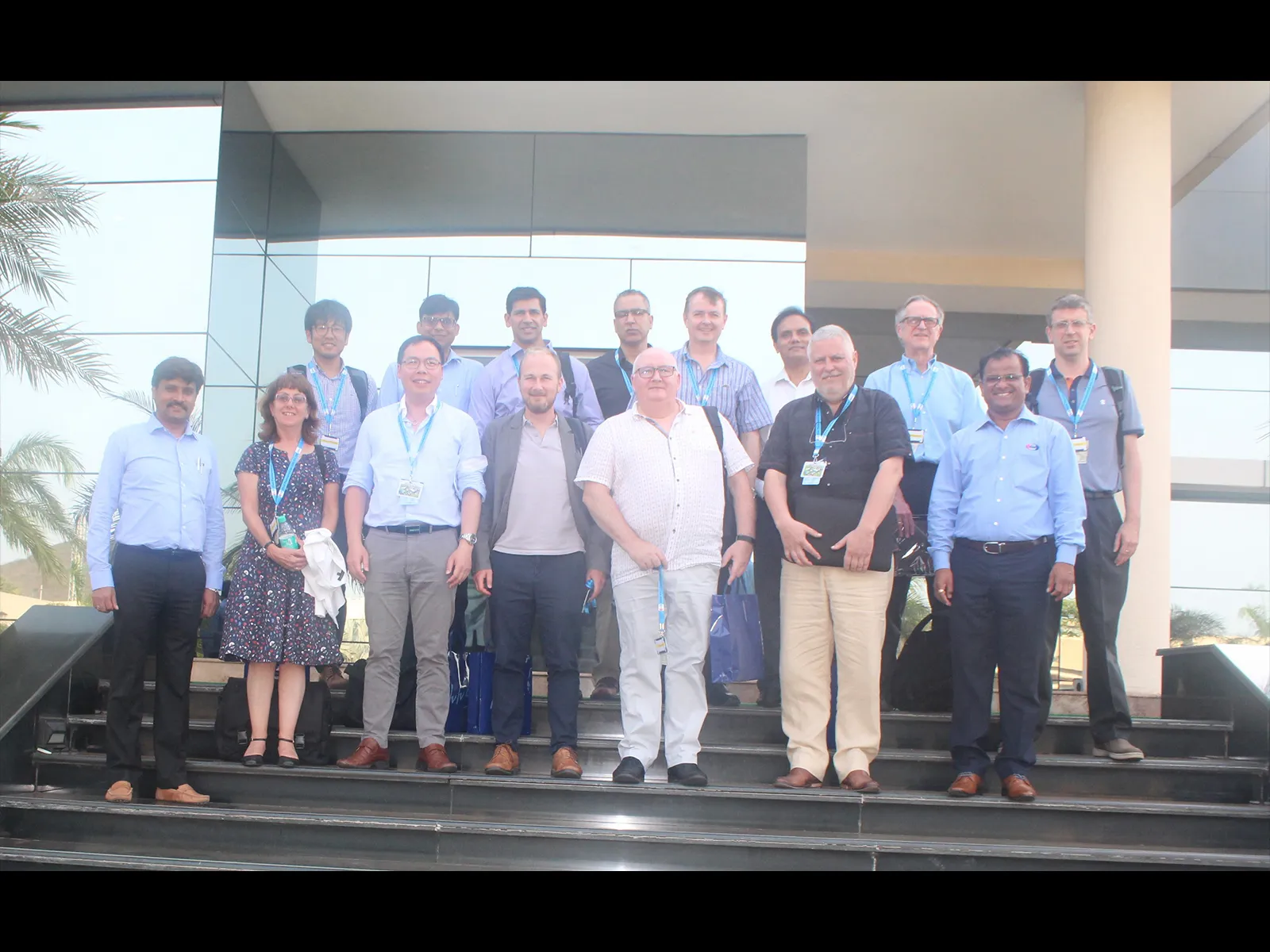Winner: 2024 Chemistry Biology Interface Horizon Prize: Rita and John Cornforth Award
A∙WOL antifilarial drug discovery team
For the discovery of fast-acting, highly specific anti-Wolbachia candidates for the oral treatment of human filariasis.

The A·WOL antifilarial drug discovery team is a collaboration between the University of Liverpool, Liverpool School of Tropical Medicine, Imperial College London, University of Bonn and industrial partners from Astra Zeneca and Eisai Ltd.
Biography
Lymphatic filariasis (elephantiasis) and onchocerciasis (river blindness) cause severe disability and affect more than 117 million people globally, ranking them as one of the leading causes of global morbidity. These two neglected tropical diseases (NTDs) are caused by long-lived (10–14 years) parasitic nematodes (roundworms). The filarial worms rely on a special type of bacteria, Wolbachia.
The Liverpool team was the first to show that targeting Wolbachia with the antibiotic doxycycline leads to the permanent sterilisation of adult female parasites and the gradual death of the adult worm.
The team’s collaborative drug discovery research has led to the first synthetic drug candidate, AZ1066. This drug aims to offer a shorter treatment compared to current options and entered clinical trials in 2022. The team also identified several promising starting points for new medications and is working with Astra Zeneca to understand how these new chemical classes can eliminate Wolbachia within the worms.
Professor Paul O'Neill: "We are delighted to receive this award for our collaborative research, which has allowed us to discover a first-in-class synthetic Anti-Wolbachia (AWOL) drug candidate against filarial diseases and a portfolio of distinctive fast-acting lead molecules for further chemical optimisation."
A∙WOL antifilarial drug discovery team
The team
Prof Neil Berry, Computational Chemistry/Professor, University of Liverpool
Dr Fabian Gusovsky, Eisai Project Lead, Eisai Ltd.
Prof Achim Hoerauf, Parasitology/Professor, University of Bonn
Dr W. David Hong, Medicinal Chemistry/ Senior Lecturer, University of Liverpool
Dr Marc Hubner, Parasitology/Professor, University of Bonn
Dr Stefan Kavanagh ,Drug Safety/ Dr, Astra Zeneca
Dr Gemma Nixon, Medicinal Chemistry/ Senior Lecturer, University of Liverpool
Prof Paul O’Neil, PI Med Chem/ Professor, University of Liverpool
Prof Ed Tate, Chemical Biology/ Professor, Imperial College London
Prof Mark Taylor, Parasitology AWOL lead /Professor, Liverpool School of Tropical Medicine
Prof Joe Turner, Parasitology/Professor, Liverpool School of Tropical Medicine
Prof Steve Ward, Parasitology/Professor, Liverpool School of Tropical Medicine
Dr Peter Webborn, DMPK/Dr, Astra Zeneca
Dr Mark Wigglesworth, High throughput screening/ Dr, Astra Zeneca
Q&A
What was your role within the team?
Gemma Nixon: Within the team I was involved with the identification and assessment of the chemical starting points, development and optimisation of the hit series and other medicinal chemistry activities within the project.
What were the biggest challenges in this project?
Paul O'Neill: The biggest chemistry challenges within the project included designing molecules that could achieve all of the drug candidate profile targets and also to provide synthesis routes that could be scaled. With both Astra Zeneca and Eisai in collaboration these challenges were met.
David Hong: Using medicinal chemistry strategies to identify and overcome the translation between in vitro activity and in vivo efficacy.
What different strengths did different people bring to the team?
Mark Taylor: The team is truly multidisciplinary, with each member bringing their individual expertise to the project. Strengths lie in medicinal chemistry, chemical biology, parasite and Wolbachia biology both within cells and animals, industrial screening platforms, clinical trials expertise and many more. Experts within the team were from both multiple industry and multiple academic institutions.
Why is this work so important and exciting?
Steve Ward: Onchocerciasis and lymphatic filariasis are two neglected tropical diseases (NTDs) that together affect around 117 million people and inflict severe disability. This work has delivered a quality drug candidate and multiple other starting points to significantly contribute to the drug development pipeline in this area.
Where do you see the biggest impact of this technology/research being?
David Hong: This work has the potential to deliver new drugs for the treatment of onchocerciasis and lymphatic filariasis by targeting Wolbachia within the adult female nematode leading to gradual parasite death. This provides a significantly better patient outcome than existing drugs, which directly kill the nematode – this is associated with significant side effects.
How will this work be used in real life applications?
Joe Turner: Our work holds tremendous potential to be translated into novel therapeutic treatments for both human and veterinary filariasis. Establishing a seven-day short-course anti-Wolbachia curative treatment would be a powerful and disruptive new tool to accelerate the elimination of human filarial neglected tropical diseases as a major global health problem, particularly in regions of Central Africa where other approaches are not suitable for deployment.
How do you see this work developing over the next few years, and what is next for this technology/research?
Joe Turner: We continue to maintain an active anti-Wolbachia translational research programme, and our collaborative focus is now to explore the structure-activity relationship of exciting new chemistry emerging from screening the 1.3 million AZ diversity library with the promise of deriving sub-seven-day candidates ready for clinical testing against river blindness.
What inspires or motivates your team?
Joe Turner: Working on exciting and fascinating medicinal chemistry solutions which also have the potential to deliver life-changing health impacts for some of the most marginalised in global society are major motivating factors.
What is the importance of collaboration in the chemical sciences?
Neil Berry: Collaboration is crucial in the chemical sciences – at every level individual, institutional/company and extra-institutional/company.
Gemma Nixon: Collaboration is imperative as it brings together multidisciplinary teams to maximise the expert knowledge within a team and ultimately ensure project success.
What does good research culture look like or mean to you?
Gemma Nixon: Good research culture should be open, inclusive and value both the research process and findings in equal measure. A constructive, collaborative research environment is key to achieving this.
Neil Berry: A good research culture is one that attracts, develops and retains a diverse community of talented people.
David Hong: Good research culture means working together as a team with a common goal, in which team members are open and trustful to each other. A strong leadership is essential for this too.
How are the chemical sciences making the world a better place?
Gemma Nixon: Chemical Sciences play a pivotal role in so many aspects of everyone’s day-to-day life. From the medicines we take, products we use in our homes through to the technology we use on a daily basis. The contribution it makes to society should not be underestimated.
Neil Berry: Chemical sciences deliver positive changes to society and the economy.
What advice would you give to a young person considering a career in chemistry?
David Hong: Be patient and resilient – work in chemistry can be challenging sometimes. There are lots of ups and downs in the way of creating or finding new medicines.
Neil Berry: A career in chemical sciences will enable you to be impactful in a rapidly changing world.
Gemma Nixon: A career in the chemical sciences can be hugely rewarding and there are a multitude of career paths within the area. Speak to as many people as possible about those career paths to scope the options available.
Our winners
We are recognising individuals, collaborations and teams for their exceptional achievements in advancing the chemical sciences. Explore our prize winners, and discover and share their stories
Thank you to everybody who took the time to make a nomination this year, and to all of our volunteers on our judging panels.
